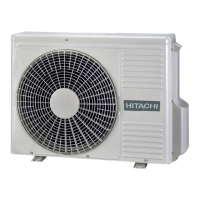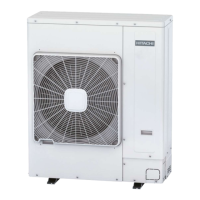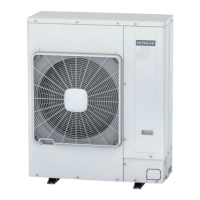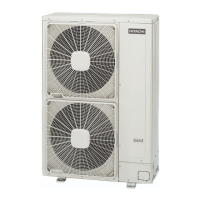3 Piping work and refrigerant charge
Refrigerant charge
SMGB0136 rev.0 - 07/2021
60
3.4.1 Caution of the pressure by check joint
When the pressure is measured, use the check joint of gas stop valve (A), and use the check joint of liquid piping (B) in
the gure below.
At that time, connect the pressure gauge according to the following table because of high pressure side and low pressure
side changes by operation mode.
RAS-3HVRC2 RAS-(4-6)H(V)(R/N)(C/P)2E
C
A
C
B
A
Cooling operation Heating operation
Check joint for gas stop valve -A- Low pressure High pressure
Check joint for piping -B- High pressure Low pressure
Check joint for liquid stop valve -C- Exclusive for vacuum pump and refrigerant charge
? NOTE
Be careful that refrigerant and oil do not splash to the electrical parts at removing the charge hoses.
3.4.2 Refrigerant charge quantity
Although refrigerant has been charged into this unit, additional refrigerant charge is required according to piping length.
1 The additional refrigerant quantity should be determined and charged into the system according to the following
procedure.
2 Record the additional refrigerant quantity in order to facilitate maintenance and servicing activities.
! CAUTION
• When charging refrigerant, measure the amount precisely. Overloading or underloading of refrigerant may cause compressor prob-
lems. If the actual piping length is less than 5 m consult your dealer.
• Appropriate refrigerant
The refrigerant used in each unit is identied on the specication label and manuals of the unit. Hitachi shall not be held liable for any
failure, trouble, malfunction or accident caused by units illegally charged with refrigerants other than the specied one.
• Consequences of charging non-specied refrigerant
• It may cause mechanical failure, malfunction and other accidents. It may cause operational failure of protection and safety devices of
air conditioners. It may also cause lubrication failure of the sliding part of the compressor due to deterioration of refrigerant oil.
• In particular, hydrocarbon refrigerants (such as propane, R441A, R443A, GF-08, etc.) are not allowed, since these are combustible
and may cause major accidents such as re and explosion in case of improper handling.
• Once a non-specied refrigerant has been charged, no further servicing (including draining of refrigerant) shall be performed, even
in case of malfunction. Improper handling of refrigerant may be a cause of re and explosion, and servicing in such cases may be
considered an illegal act.
• End clients and costumers shall be informed that servicing is not approved, and the installer who charged the non-specied refrigerant
shall be asked to x the unit.

